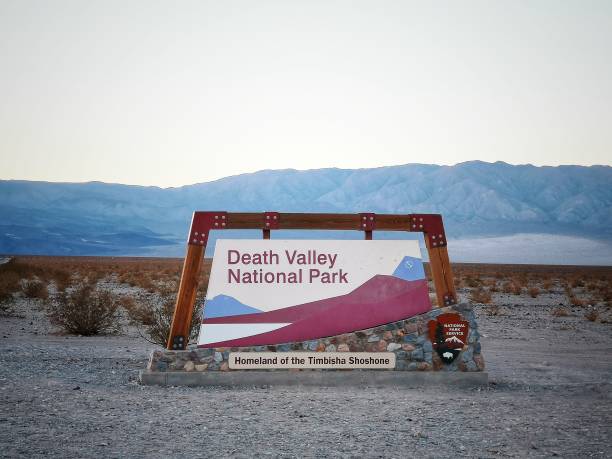Death Valley National Park is one of the parks that are suitable for year-round visits. This is the hottest place on Earth, with a recorded temperature of 134-degree Fahrenheit (57-degree Celcius) on July 10, 1913.
In this article, I’ve gathered all the necessary details required to visit this national park, which I used during my last visit.
Death Valley Yearly Temperature:
Whenever you visit Death Valley, it’s essential to know about the current Temperature in this park. The following table shows the yearly Death Valley temperatures.
| Month | High | Low | Rain |
| January | 67° F / 19° C | 40° F / 4° C | 1 day |
| February | 74° F / 23° C | 46° F / 8° C | 1 day |
| March | 82° F / 28° C | 55° F / 13° C | 1 day |
| April | 90° F / 32° C | 62° F / 17° C | 0 days |
| May | 100° F / 38° C | 72° F / 22° C | 0 days |
| June | 110° F / 44° C | 82° F / 28° C | 0 days |
| July | 116° F / 47° C | 88° F / 31° C | 0 days |
| August | 114° F / 46° C | 86° F / 30° C | 0 days |
| September | 107° F / 41° C | 76° F / 24° C | 0 days |
| October | 93° F / 34° C | 62° F / 17° C | 0 days |
| November | 77° F / 25° C | 48° F / 9° C | 0 days |
| December | 65° F / 19° C | 39° F / 4° C | 0 days |

Death Valley Yearly Daylights:

Death Valley Yearly Rainfalls:

Map:
Here is the map of Death Valley National Park in PDF form. To download Click Here.
Things to do in Death Valley:
These are the most popular attractions in this park in no particular order.
Wildrose Charcoal Kilns:
This is a unique but relatively unknown location in Death Valley. I’ve never seen anything like this. Due to the higher elevation, the temperature here is pleasant. I found the temperature is almost 30-degree Fahrenheit cooler. This is an excellent location for night photography. There is a parking lot and a vault toilet available.
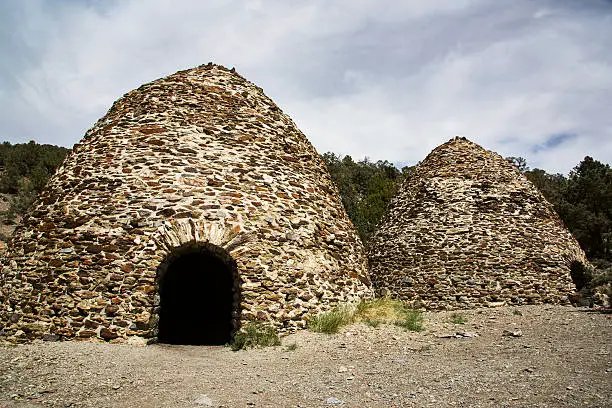
These are very well preserved kilns even after 100 years. It’s mainly because of the road. The last 2-3 miles of road are unpaved and very rough. So travel there with caution and avoid sharp rocks. When we first visited, I did not know that. Though I visited this place with our Toyota Camry, I would not do that again.
If it’s raining, don’t visit this location. After a rain, the road becomes very treacherous. There is no cell service at Wildrose charcoal kilns. So, If you are stuck, it could be challenging to get help.
Mesquite Flat Sand Dunes:
This spot is in the middle of the park and easily accessible from the road. This is the best place for kids at Death Valley. I would recommend bringing a snow or sand slider. Long sled works better than round style sleds. There are no designated trails here. So, walk wherever you like. The best time to walk here is before 10 in the morning or evening when the temperature is cooler. Carry plenty of water. Though the hikes are rated as easy, it is exhausting if you hike the dunes.
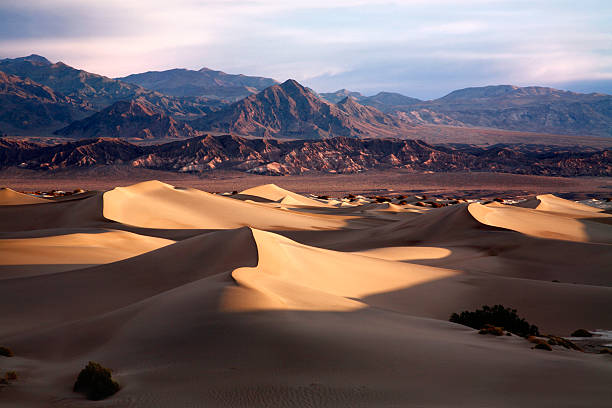
Photography is better at sunrise. Because there are almost no people at this time, and winds have erased previous days’ footprints. There is a parking lot and a vault toilet available.
Badwater Basin:
This is one of the most visited places in Death Valley. At 282 ft (86 m) below sea level, Badwater Basin is the lowest point in North America. It’s an unreal landscape of huge salt flats. Take a hike into the salt flat. Take a closer look at the salts. It’s fascinating. The best time to visit here in the afternoon because of the searing heat. Don’t forget to carry plenty of water while you walk into the salt basin.
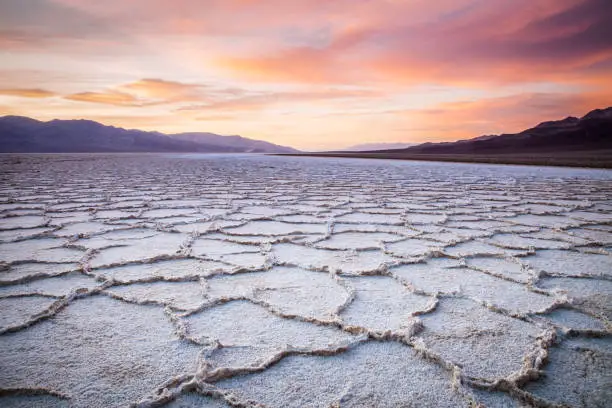
A parking lot and a vault toilet are available. During winter, parking spots fill up quickly. If there are no open spots, park at the side of the road keeping enough space for other vehicles to pass.
Zabriskie Point:
This badlands’ area is one of the must-see places in Death Valley. I highly recommend going there during sunrise or sunset. The views are breathtaking. You have to hike from the parking location to the top of the vista point. The hike is easy but uphill. The path is paved so you can take a wheelchair or stroller to the top.
Dante’s View:
It’s easy to get to Dante’s View overlook. From the viewpoint, you can see the entire valley floor and hills and surrounding hills. This vista point is 5,500 ft above sea level. So, don’t forget to carry your jacket because it’s cold up there. There is an easy trail with better views of the bad water basin.
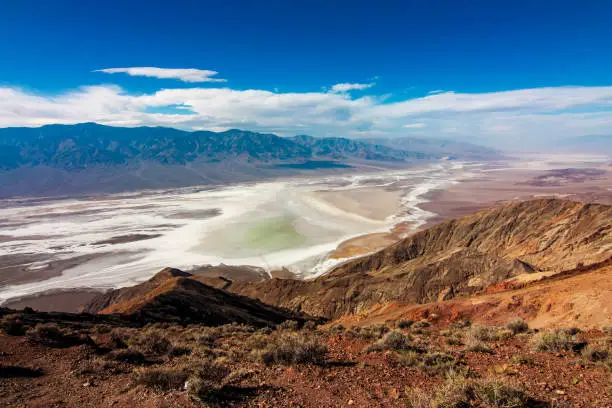
The road is winding and steep. Getting there with a trailer is impossible. There are several parking spots before you get to the top where you can park your trailer.
If you enter Death Valley from the death valley junction, cover this fantastic location before you get to the Zabriskie point or the furnace creek welcome center. Otherwise, you have to drive back here that will cost you 40 to 45 minutes.
Devil’s Golf Course:
An exciting place to see strange natural phenomena. The large salt crystal formations are very rocky and sharp. So, be careful while walking over the salts.
Google maps will take you to the wrong location. While you are on the Badwater road, wait for Devil’s Golf Course sign and then make a turn.
Artist’s Palette:
A beautiful scenic drive where Artist’s Palette is the main attraction. Artist’s Palette scenery is jaw-dropping. This is a magnificent must-see geological formation in Death Valley.
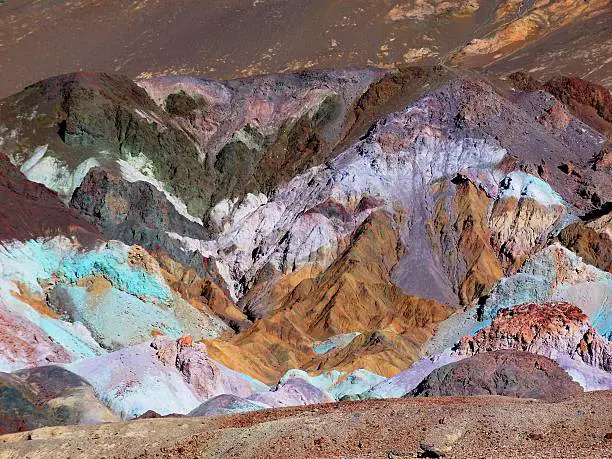
The road is one way, has some crazy dips. I enjoyed going over those dips at high speed. Visit this place either in the morning or afternoon. Summer heat is unbearable.
Darwin Falls:
A hidden gem in the Death Valley. It’s stunning in the middle of the desert.
The last 2 miles road is unpaved and would take 30 to 35 minutes. There is a parking lot. From there, you hike to the Darwin Falls. The hike is moderate but very rewarding. Please leave no trace because the water here is vital for the ecosystem and animals of this area.
Father Crowley Overlook:
Stunning views of the valley floor and canyon. If you are lucky, you could see fighter jets go through the canyon.
Furnace Creek Visitor Center:
This is the only visitor center in Death Valley. Don’t miss this visitor center. However, while you come to this place, explore every vista points you get on the road. Furnace Creek is in the middle of Death Valley. So, if you skip any of the attractions to get here, you have to go back. Which will be time-consuming.
There is an informative indoor exhibit and a 20-minute informational film that talks about the history and people of Death Valley. There is also a gift shop that sells snacks. There are ample parking spots and bathrooms here.
Ubehebe Crater:
One of the impressive geological areas in Death Valley with stunning views. There is an easy 1.5 miles loop trail around the rim of the crater.
The Racetrack:
One of the fascinating parts of Death Valley. A mysterious place with sliding rocks.
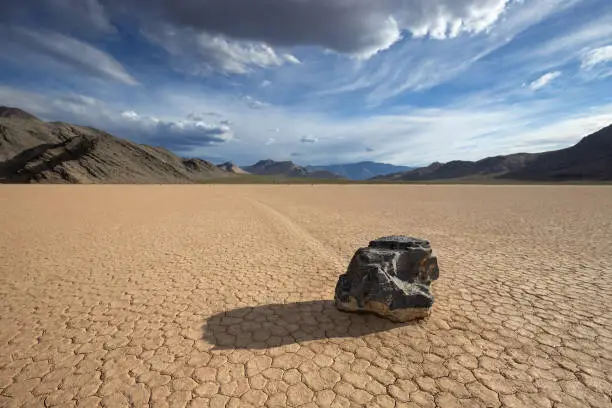
A 4×4 high clearance vehicle is recommended to visit this attraction. It takes 3 hours one way to reach Racetrack Playa from Furnace Creek visitor center. So, please plan accordingly.
Harmony Borax Works:
This is a historic borax processing plant from where the 20-mule team hauled the processed borax to market.
Salt Creek Interpretive Trail:
This is a short and accessible boardwalk to a salt creek where you can see endangered pupfish. Though the boardwalk is open year-round, the water flows down the boardwalk only from November through May. The best time to visit this attraction is February to April when the Pupfish spawn.
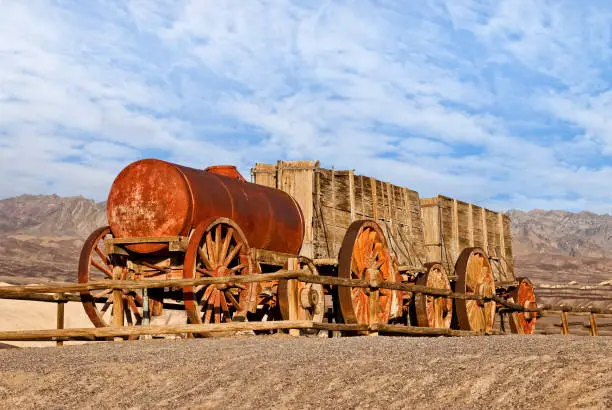
Other Attractions in Death Valley:
- Scotty’s Castle.
- Mosaic Canyon.
- Golden Canyon.
- Eureka Dunes.
- Titus Canyon.
- Golden Canyon.
- Mosaic Canyon.
- Twenty Mule Team Canyon.
- Natural Bridge Canyon.
- Aguereberry Point.
Hiking:
The best time to hike in Death Valley is in Winter months. The Summer temperatures are dangerous in here. Spring and Autumn heats are also unbearable. Death Valley is very dry. You must drink more water. I recommend carrying 2 liters of water for short winter hikes, and a minimum of 1-gallon water in warmer seasons.
Easy Hikes in Death Valley National Park:
| Easy Hikes | Round Trip | Elevation Gain |
| Harmony Borax Works | 0.4 mi (0.6 km) | 50 ft (15 m) |
| Salt Creek Interpretive Trail | 0.5 mi (0.8 km) | flat |
| Badwater Salt Flat | 1 mi (1.6 km) | flat |
| Natural Bridge | 1 mi (1.6 km) | 180 ft (26 m) |
| Mesquite Flat Sand Dunes | 2 mi (3.2 km) | 185 ft (56 m) |
Moderate Hikes in Death Valley:
| Moderate Hikes | Round Trip | Elevation Gain |
| Ubehebe Crater Rim | 1.5 mi (2.4 km) | 500 ft (152 m) |
| Darwin Falls | 2 mi (3.2 km) | 450 ft (137 m) |
| Badlands Loop / Golden Canyon / Gower Gulch Loop | 2.7 mi (4.3 km) to 4.3 mi (6.9 km) | 535 ft (163 m) to 850 ft (259 m) |
| Desolation Canyon | 3.6 mi (5.8 km) | 600 ft (183 m) |
| Sidewinder Canyon | 5 mi (8.4 km) | 1,580 ft (482 m) |
| Fall Canyon | 6 mi (9.6 km) | 2,460 ft (752 m) |
| Dantes Ridge | 8 mi (13 km) | 1,200 ft (366 m) |
| Panamint Dunes | 7 mi (11.3 km) | 1,028 ft (313 m) |
Difficult Hikes in Death Valley:
| Difficult Hikes | Round Trip | Elevation Gain |
| Mosaic Canyon | 4 mi (6.4 km) | – |
| Wildrose Peak | 8.4 mi (13.5 km) | 2,200 ft (671 m) |
| Telescope Peak | 14 mi (22.5 km) | 3,000 ft (914 m) |
Gas station:
Death Valley is an enormous park. When you enter, make sure you have a full tank of gas. Though there are three gas stations inside the park, the prices are very high. The gas stations are located in the following locations:
Furnace Creek: Open 24 hours. Unleaded gasoline, diesel, and propane available here.
Stovepipe Wells Village: Open 24 hours. Unleaded fuel only.
Panamint Springs: Open from 7 am to 9:30 pm. Unleaded fuel only.
Camping at Death Valley:
In the summer, always camp at a campground with higher elevation. Summer heat here is intolerable. Campground at a higher altitude is way cooler than sea level at the Death Valley. For example, From my experience, I found that the Wildrose Campground is almost 40° Fahrenheit cooler than Furnace Creek Campground. However, at a higher elevation, there could be high wind. So, always use stake while tenting.
| Campground | Elevation | Fee | Water | Toiles |
| Furnace Creek | -196 ft (-60 m) | $22 standard$36 hookups | Yes | Flush |
| Sunset | -196 ft (-60 m) | $14 | Yes | Flush |
| Texas Springs | Sea Level | $16 | Yes | Flush |
| Stovepipe Wells | Seal Level | $14 | Yes | Flush |
| Mesquite Spring | 1,800 ft (549 m) | $14 | Yes | Flush |
| Emigrant | 2,100 ft (640 m) | Free | Yes | Flush |
| Wildrose | 4,100 ft (1,250 m) | Free | Yes | Vault |
| Thorndike(4×4 suggested) | 7,400 ft (2,256 m) | Free | No | Vault |
| Mahogany Flat (4×4 suggested) | 8,200 ft (2,499) | Free | No | Vault |
Note: Senior/Access Pass Rate holders enjoy a 50% discount at all campgrounds at Death Valley.
Campground Reservation:
Only the Furnace Creek campground requires a reservation in winter. No reservation is required for all other campsites. To reserve Furnace Creek, please visit this recreation.gov site.
There are three private campgrounds at Death Valley. These are:
| Campground | Elevation | Fee | Water | Toiles |
| Fiddler’s Camp | -218 ft (-66 m) | $24 | Yes | Flush |
| Stovepipe Wells RV Park | Sea Level | $40 (Hookups). $20 (senior/access pass) | Yes | Flush |
| Panamint Springs | 2,000 ft (610 m) | $35 hookups. $20 non-hookup. $10 tents. $50-65 tent cabins. | Yes | Flush |
Private Campground Reservation:
To make a reservation to the private campgrounds at Death Valley, please visit their website or call them.
Fiddler’s Camp – Website https://www.oasisatdeathvalley.com/
Stovepipe Wells RV Park – Website https://deathvalleyhotels.com/our-hotel/rv-park-and-camping/
Panamint Springs – https://www.panamintsprings.com/reservations/
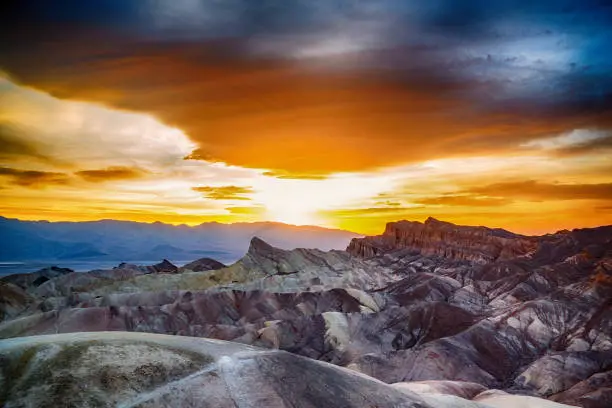
Lodging:
I highly recommend you stay inside the death valley. There are three Lodging location inside this park. These are –
- The Oasis at Death Valley
- Death Valley Lodging Company
- Panamint Springs Resort
However, if lodging is unavailable and you don’t like camping, then you could stay at any nearby locations. For example, at Beatty, at Panamint Springs, or Death Valley Junction.
Nearby Communities:
East of the Death Valley:
Death Valley Junction, California:
A 30-minute drive from Furnace Creek. Lodging, restaurant, and RV camping available.
Beatty, Nevada:
A 45-minute drive from Furnace Creek. Lodging, restaurants, ATM, camping, gas, and general store available.
Amargosa Valley, Nevada:
1-hour drive from Furnace Creek. Lodging, gas, and restaurants available.
Pahrump, Nevada:
1-hour 15-minute drive from Furnace Creek. Lodging, restaurants, grocery stores, hospital, auto service, gas, ATM, veterinarians, camping.
Shoshone, California:
1-hour drive from Furnace Creek. Lodging, restaurants, general store, gas, and campground available.
Tecopa, California:
1-hour 15-minute drive from Furnace Creek. Lodging, restaurants, camping.
Las Vegas, Nevada:
2-hour 30-minute drive from Furnace Creek. Lodging, restaurants, grocery stores, hospital, auto service, gas, ATM, veterinarians, camping.
West of the Death Valley:
Trona, California:
1-hour 30-minute drive from Furnace Creek. Lodging, restaurants, camping, gas, and ATM available.
Ridgecrest, California:
2-hour drive from Furnace Creek. Lodging, restaurants, grocery stores, hospital, auto service, gas, ATM, veterinarians, camping.
Lone Pine, California:
1-hour 30-minute drive from Furnace Creek. Lodging, restaurants, camping, gas, ATM, groceries, and health clinics available.
Backcountry Camping At Death Valley:
The whole Death Valley is designated as wilderness area except the roads and 50 feet from the road line. At over 3.1 million acres of wilderness, Death Valley is the largest federally designated wilderness outside Alaska. You can collect a free backcountry camping permit from the furnace creek visitor center. The heat at this park is brutal. If I were you, I would not go backcountry camping in the summer.
This is a desert. Even biodegradables items such as nutshells, apple cores, and orange peels would take years to break down here. So, please pack out your trash.
Food:
There are several dining options inside Death Valley. These are:
- The Inn at Death Valley – Breakfast, lunch, and dinner.
- The Ranch at Death Valley – There are few different dining options at this location.
- Toll Road Restaurant.
- Badwater Saloon.
Dump Station inside Death Valley:
Following six campgrounds has a dump station:
- Furnace Creek
- Sunset (Closed in Summer)
- Texas Springs (Closed in Summer)
- Stovepipe Wells (Closed in Summer)
- Mesquite
- Stovepipe Wells RV Park (Private Campground)
Shower at Death Valley:
You can take a shower at the following locations at Death Valley –
Furnace Creek Ranch Resort: Per person shower passes available from 8 am to 10 pm. The passes cost $5 per person as of writing this article. Go to the hotel front desk to buy them. However, if you don’t get any pass there, then go to the next location.
Stovepipe Wells Village: Per person shower passes available daily until midnight. The passes cost $4 per person. In my experience, this is the best deal here. The showers are clean and very pleasant. For shower related information, visit the front desk at stovepipe wells village.
Panamint Springs: Shower passes available at the general store.
Entrance Fee:
Unlike other National Park, Death Valley does not have any entrance fee booth staffed by a park ranger. But there are automated fee machines at every entrance gate. You can also pay an entrance fee at the visitor center.
7-day Passes:
| Vehicle and passengers | $30 |
| Motorcycles | $25 |
| Individual entering on bicycle or foot | $15 |
Lifetime Passes:
| Interagency Lifetime Senior Pass (for U.S. citizens 62+) | $80 |
| Interagency Lifetime Access Pass (for U.S. citizens with a disability) | Free |
Annual Passes:
| Death Valley Annual Pass | $55 |
| Interagency Annual Pass | $80 |
| Interagency Annual Senior Pass (for U.S. citizens 62+) | $20 |
| Interagency Annual Military Pass (for active duty and dependents) | Free |
What Should I Do If My Vehicle Breaks Down At Death Valley?
Cell service in death valley is not good. If its an emergency and you have cell service call 911. If there is no cell service, you should flag down any available motorist to alert park staff that you need help. Death Valley is extremely hot. Don’t leave your vehicle and attempt to walk.
Towing inside the Death Valley is expensive. Towing will cost you, on average, $2000 off of paved roads.
If I were you, I would never drive off-road inside Death Valley. Here’s why:
- It’s illegal.
- Death Valley attracts visitors from around the world. Tire tracks mar the landscape which takes decades to heal. It destroys Death Valley’s stunning views.

Rangers regularly organize volunteer brigades to repair damage from off-road driving. Organizing, housing, and supervising these groups cost money. Damage done in a few minutes takes these groups days to rehabilitate.
Pets in the Death Valley:
Other than service animals, pets are not allowed on trails, into the wilderness, out of developed areas, and inside most of the buildings.
Download Offline Maps:
Cell service inside Death Valley is almost non-existent. I highly recommend you to download Google maps for offline use. To learn how to download google maps for offline use, visit this Google Tutorial.
Where are the best places to view the Night Sky in Death Valley?
- Harmony Borax Works.
- Mesquite Flat Sand Dunes.
- Badwater Basin.
How many days are required to visit each attraction in Death Valley?
For us, it took 5 days to visit each attraction in Death Valley. However, 2 full days is enough to hit all the major attractions in this park.

Nearby Must-See Attractions:
- Rhyolite
- Goldwell Open Air Museum
Conclusion:
Death Valley Nation Park is very hot and humid. Please carry a lot of water and enough food.
